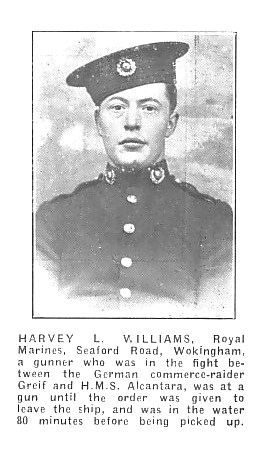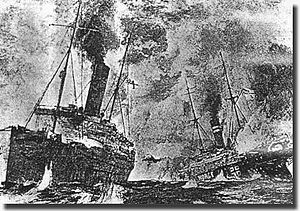 Harvey Llewelyn Williams Died 1919
Harvey Llewelyn Williams Died 1919
Harvey Llewelyn Williams was born in Reading and by the age of 16 was a labourer to a Brewery Analyst, a job found by his father, a brewery blacksmith. Harvey died in 1919 as a result of an illness, which was possibly connected to an incident referred to beneath his attached photo. At the time, he lived in Lynton Cottage, Seaford Road, Wokingham, which we now know as the main area of our naval and military loss. He was a Royal Marine, which had seen action at Gallipoli and Jutland, although it appears Harvey’s own injury was caused during a sea battle between his ship, HMS Alcantara and a German commerce raider, Greif. Below, take a look at Harvey’s tree and note the loss suffered by the parents even before Harvey’s death. Via a mistake in the Census record of 1911 (see below), we can see the Williams family had lost three babies, Frederick at 2 months and Albert and Reginald both only a year old. Harvey is buried at All Saints Church, Wokingham.
The action between the HMS Alcantara and the Greif is described by Wikipedia:
‘Just launched, the 5,000 ton auxiliary cruiser SMS Greif was armed with four hidden 15-centimeter guns, one hidden 10.5-centimeter gun and two torpedo tubes. She was home to over 300 officers and crewmen. Greif had just left her home port of Hamburg into the North Sea when a British submarine spotted her and reported her position to the Admiralty on February 28. Admiral Jellicoe sortied five cruisers and seven destroyers to sweep the North Sea with the auxiliary cruisers HMS Alcantara and HMS Andes which were already on patrol. The British auxiliary cruisers both weighed about 15,000 tons and carried eight 6-inch and two 3-pounders each. Four Royal Navy warships encountered the Greif, including the two auxiliary cruisers, there was the light cruiser HMS Comus and the destroyer HMS Munsterwhich arrived at the very end of the action.
At about 8:45 am on February 19, 1916, lookouts aboard the Alcantara spotted smoke off the port beam so her commander Captain Thomas Erskine Wardle maneuvered closer to identify what the smoke was coming from. Unbeknown the smoke was from SMS Greif. A few minutes later HMS Andes reported that her lookouts had sighted a ship with two masts and a black funnel headed northeast. Two Norwegian steamers were also observed, flying their large flags. The two British vessels closed on the Greif until within range to signal one another. First Captain Wardle ordered the German vessel to stop and two blank rounds were fired. The Germans hove to and signaled that they were from Trondheim and were headed for Rio de Janeiro. At about 9:40 the British were close enough to the raider so they lowered a few boats with a boarding party to take command of the seemingly harmless steamer. At this moment the raider revealed her intentions, unmasked her guns and opened fire on the Alcantara at a range of 800 yards. The first discharge struck the Alcantara‘s bridge which caused heavy damage and destroyed the communications equipment. Further shots hit and sank some of the boarding party’s boats and also knocked out the Briton’s steering gear.
Alcantara increased her speed and began returning fire as the Germans attempted to flee towards the Norwegian coastline. Her first shot struck and disabled the Greif‘s poop gun, killing the crew in the process. For several minutes the two vessels dueled at close range until gun fire was heard by the Andes which was about five miles from the battle area. She closed to within three miles of SMS Greif and opened fire. Her first shots struck the bridge of the German raider and destroyed its steering gear. The Germans attempted one last desperate move, a torpedo attack. Greif launched two torpedoes at the Alcantara, the first one hit amidship and the second passed under the stern. By the end of the engagement, the British knocked out another German gun and set her fuel tanks on fire, one shot entered the hull of the Greif, exploded, and slowed the vessel to a sinking halt. Reports say that both the Greif and Alcantara were struck several times at or below the waterline which left the British vessel in a sinking state as well. German fire ceased at 10:18 am and a few minutes later the Royal Navy sailors spotted life boats being lowered from the burning Greif.
The British kept up their fire and as the German commander climbed down the rope to his life boat, shrapnel struck him in the neck and he was beheaded. Several moments later Captain Wardle ordered his men to abandon ship and at 11:02 the Alcantara was underneath the water. Around this time the Comus and Munster arrived and finished sinking the German raider. Wardle and his surviving crew were in the water for about twenty minutes before being picked up. An estimated 187 Germans perished along with seventy-two Britons, five officers and 120 Germans were rescued and taken prisoner by the Andes and Munster.’
WILLIAMS, HARVEY LLEWELLYN
Rank: Private
Service No: PO/17130
Date of Death: 28/03/1919
Age: 24
Regiment/Service: Royal Marine Light Infantry, Portsmouth Div.
Grave Reference. C. 895.
Cemetery WOKINGHAM (ALL SAINTS) CHURCHYARD
Additional Information: Son of Frederick W. and Henriette Williams, of Lynton Villa, Seaford Rd., Wokingham.
Lynton Cottage, Seaford Road, Wokingham
[iframe_loader width=”920″ height=”675″ frameborder = “1” longdesc=’ ‘marginheight=’0′ marginwidth=’0′ name=’ ‘click_words=’ ‘click_url=’ scrolling=’yes’ src=’http://wokinghamremembersco.ipage.com/Family trees/Williams Harvey’]



Harvey died in March 1919 from an unspecified disease. His loss is recorded by the Royal Navy records and is remembered on Wokingham’s war memorial. This at least indicates that he died as a result of war time injury / illness. The question here is, if the illness was connected to the war, how long had he suffered for? Although it is possible his time in the water may have contributed to his illness, the battle between Alcantara and the Greif took place 29 February 1916 (a leap year). Another mystery is that the Atlantic in February is a very cold place, how did he last eighty minutes and survive?